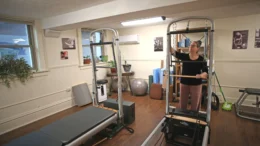With the advent of uniform narrow canopy training systems, the “artistry” of pruning can be phased out in favor of pruning to a few scientifically sound principles.
The primary goals of pruning in a high density orchard system are to maintain even light distribution throughout the narrow tree canopy, to facilitate movement of air and crop protectant sprays within the canopy, and to balance vegetative and reproductive growth. These goals are met by thinning out large-size primary branches so as to maintain the thin spindle canopy shape, leaving an appropriate number of smaller side branches growing from a single vertical trunk, and spaced out at an appropriate branch density. Branches that have an upright angle (under 40 degrees of vertical) are too strong, and those branches that are too pendant (over 140 degrees from vertical) are too weak. Branches <40 or >140 degrees are pruned off, retaining more horizontal branches that will possess a better balance between growth and fruitfulness. Finally, each side branch is thinned to maintain a single axis with minimal branch complexity. Thus, we propose that there are four prioritized categories or “orders” of pruning rules that should be followed:
1. Pruning based on branch size
2. Pruning based on branch number per meter of the trunk (branch density)
3. Pruning based on branch angle
4. Pruning based on secondary branch complexity.
Excess side branches are removed, leaving a short “duckbill” shaped stub at the base to stimulate renewal growth. These renewal branches will develop over time, and will eventually replace the current side branches when these have grown too large and must be pruned off. Renewal pruning is key to obtaining large attractive fruits growing on healthy spurs in a favorable light environment. Apple bears fruit from mixed buds and on different ages of wood, with the primary bearing surface comprised of spurs on wood that is two years old or older. In the past, the volume and branching complexity of the apple tree canopy made it extremely difficult to create a simple, predictable, and repeatable set of rules for pruning. Horticulturists often cited the “art and science of pruning.” With the advent of uniform narrow canopy training systems on dwarfed trees with a simple branching structure that is enforced by renewal pruning, the “artistry” can be phased out in favor of pruning to a few scientifically sound principles. A prioritized set of apple pruning rules based upon these principles follows.
Branching and Pruning Terminology
– The leader is a single vertical extension of the trunk from which all secondary branches originate; aka: vertical axis; or tall spindle. Maintaining the dominance of this leader/ axis/ tall spindle results in a tall, narrow cone-shaped canopy.
– Vertical Axis usually refers to trees at moderate spacing (5 X 14 ft, 622 trees/Acre)
– Vertical Axis trees in the U.S. may have 3 to 5 semi-permanent scaffold limbs in the lower canopy.
– Spindle usually refers to trees at spacing ≤ 4 X 12 ft; ≥ 908 trees/Acre, with no permanent scaffolds
– A secondary branch, aka limb, or scaffold, is a side branch that originates from the leader.
– A tertiary branch is a branch that originates from a secondary branch.
– A thinning cut is a pruning cut that removes the branch near its point of origin.
– A heading cut is a pruning cut that removes only a portion of a branch.
– A renewal cut refers to a hybrid cut that thins out the canopy by removing nearly all the branch, but leaves a short duckbill stub. This is done to stimulate a new shoot to sprout near the base of the original branch.
– A stubbing cut refers to a heading cut made into 2 to 3-year-old wood on wide angle secondary branches to create a shorter or less pendant new axis.
Universal Pruning Rules for Vertical Axis and Spindle Systems
1. Identify the central leader. It is the only permanent structure in the branch framework.
2. There can be only one central leader.
Prioritized Pruning Tasks
1. Once the leader exceeds desired final height, it is headed to a short side branch by cutting into 2-3-year-old wood to maintain tree height at the desired height. This cut is delayed, and the initial tree height is allowed to exceed the final height, to allow fruiting of the leader to help slow regrowth. If desired, a taller tree height can be maintained in plantings with wider between-row spacing. Final tree height = (2 * free alley width).
2. Maintain the narrow cone shape by thinning out longer shoots in the top third of the canopy.
3. Remove any secondary limb when the limb diameter becomes half as large as the diameter of the leader at its point of origin. The exception is the 3-5 semi-permanent scaffolds that are retained in Vertical Axis trees. All other primary branches follow this rule.
4. Select and remove the 2, 3, or 4 (choose your number) largest remaining side branches from the leader, leaving a short duckbill stub to stimulate limb renewal.
5. Remove all damaged or diseased limbs.
6. Potential crop load is then managed by thinning out additional secondary branches, spacing them out, to reduce the number of secondary branches to a total of 30 – 36 (choose your number, based on yield expectations).
7. Remove all other vertical shoots with an angle of <40 degrees relative to the central axis.
8. Each remaining side branch is also pruned to a single axis, by either thinning any tertiary branches that are less than half the diameter of the secondary branch, or stubbing the drooping limb back to a new axis.
A final check is made
Is the tree shape a tall narrow cone with one leader?
Are there about 30 – 36 (choose your number) secondary branches of various sizes?
Are the secondary limbs spaced out radially? Vertically?
This educational blog is a series of informative articles from the Penn State Master Gardeners volunteers plus news concerning the group and their activities. For more information, click here.































